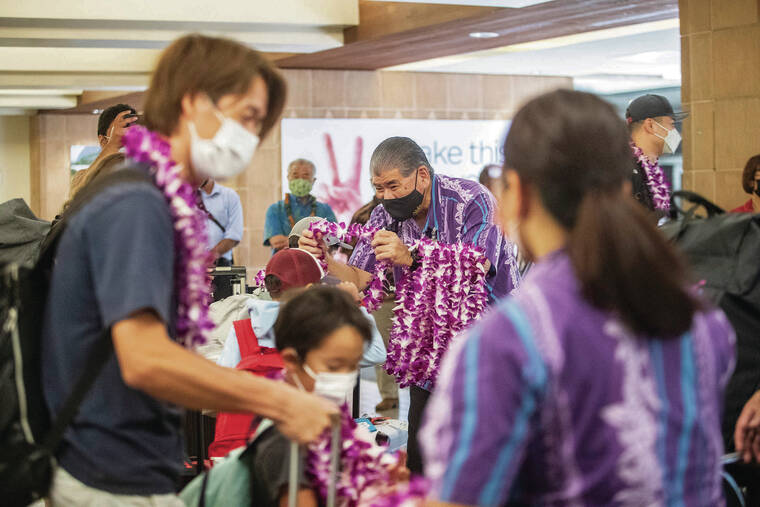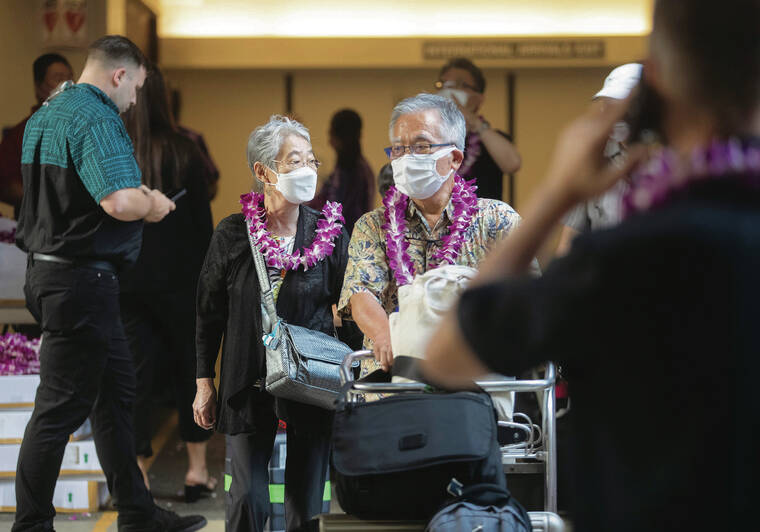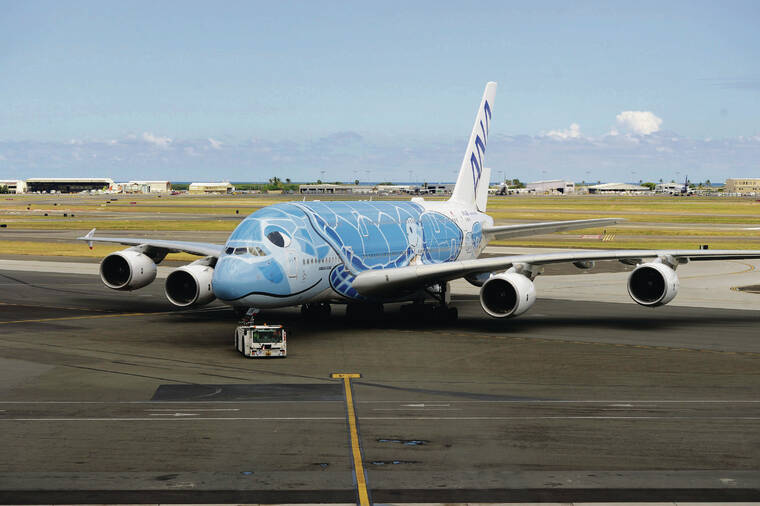The turtles are flying again in Hawaii — a superjumbo jet-size sign that visitors from Japan are returning.
All Nippon Airways on Friday flew its first Airbus A380 into Hawaii since the pandemic surfaced. The “Flying Honu,” painted to look like a friendly turtle, retails for hundreds of millions of dollars and is approximately the length of a 20-story building. It touched down with 414 of its 520 seats filled.
Among the passengers were Hiroki and Ari Ito, who have scheduled a wedding Sunday at the St. Catalina Chapel in Waimanalo. The couple said they took a graduation trip to Hawaii seven years ago and had been waiting for the pandemic to settle down so they could celebrate their nuptials where they first fell in love. Travel restrictions made the trip difficult, they said.
“Hawaii is a very special place for us,” Hiroki Ito said. Ari Ito added, “Our first trip to Hawaii together was a very memorable trip. We’ve been waiting a long time to come back.”
Hawaii’s visitor industry also has been pining for Japanese tourism, which was decimated by the pandemic, to return.
Japan Association of Travel Agents Chair Hiroyuki Takahashi told the Honolulu Star-Advertiser, following a reception in April at the Hawai‘i Convention Center, that he expected the recovery of Japanese visitors to Hawaii would start with the popular Golden Week travel period in spring, with significant returns by summer. But so far, visitors from Japan are returning at a slower pace.
Tetsuya “Ted” Kubo, president and CEO of JTB Hawaii Inc., who was at the ANA A380’s arrival to greet customers, said JTB Hawaii is now opening its customer service center at Ala Moana Center, but noted that the company will wait until Oct. 1 to reopen shuttered hotel lounges and restart its trolley service.
“We hope to see more visitors from Japan return soon,” said Kubo, whose company has been scaling up since the resumption of package tours from Japan to Hawaii for Golden Week. “The return of the Flying Honu is exciting,” he said.
Still, even with the return of ANA’s A380s, most of Hawaii’s visitor industry isn’t expecting to see significantly higher volumes of visitors from Japan for at least a few months.
Earlier this year, Hawaii Hotel Alliance President Jerry Gibson said hoteliers had thought visitors from Japan would return in the summer, but the large-scale return keeps getting pushed back. “Now we think it might not happen until mid- September or October,” Gibson said.
Kubo said Hawaii travel sellers in Japan plan to launch an education campaign in mid-July to help reassure travelers that travel to Hawaii is safe, and to answer questions about travel requirements in Japan.
The activity builds on the welcome that Gov. David Ige sought to convey in May when he visited Japan with a delegation that included Mike McCartney, director of the state Department of Business, Economic Development and Tourism; John De Fries, president of the Hawaii Tourism Authority; George Kam, chair of HTA’s board; and state House Speaker Scott Saiki.
Ige reaffirmed his commitment to rekindling tourism from Japan at the ANA event. “After two long years of living through the COVID pandemic, we are excited to welcome back tourism from Japan. We know that they are excited to be back as well,” Ige said. “We look forward to a great summer and the return of the Japanese visitor to the pre-pandemic levels.”
That endeavor comes with challenges. Japan’s border controls to curb the spread of coronavirus infections began gradually loosening earlier this month. But travelers must still face testing requirements, and plan so that their trips fall within Japan’s daily cap on arrivals of 20,000 people.
Japan, a crowded island nation, is wary about outside risks and infectious diseases. The crowds are finally back in Tokyo with a gradual relaxing of the city’s COVID-19 restrictions, which called for restaurants to close early and people to social-distance and limit attendance at events. But worries about COVID-19 remain.
Economic concerns may also be contributing to lower-than-expected travel demand. The Japanese yen has weakened this year against the U.S. dollar. Additionally, fuel surcharges are high: Now set at about $175 per person, the rate is expected to jump to about $225 per person in August.
The slow return of visitors from Japan prompted a debate Thursday at a Hawaii Tourism Authority board meeting. To avoid overspending for a market that has not yet materialized, some HTA board members favored holding back $500,000 from the $6.5 million that had been set aside for marketing travel to Hawaii in Japan in fiscal year 2023. In the end, though, the board supported HTA Chief Brand Officer Kalani Ka‘ana‘ana’s recommendation to allocate the full amount.
Ka‘ana‘ana, who attended the ANA event, said, “The international portion of the recovery is the part that needs the most support.”
While the U.S. travel market to Hawaii has surpassed 2019 levels for the past 13 months, travelers from Japan in May were still 93.7% below the visitor arrivals count in May 2019.
Historically, Japan has been Hawaii’s top international market. More than 1.5 million visitors came to Hawaii from Japan in 2019 and spent more than $2 billion.
McCartney, DBEDT’s director, pointed out that May marked Japan’s highest month for visitor arrivals since April 2020. Still, DBEDT reported that there were just 7,167 visitors from Japan in May — compared with 113,226 visitors who came to Hawaii in May 2019. Visitors from Japan spent $15.6 million in May, down 90.4% from $162.4 million in May 2019.
There were 89 scheduled flights from Japan with 20,509 seats in May, compared with 641 scheduled flights with 161,248 seats in May 2019.
McCartney said the return of ANA’s A380s, which first arrived here in May 2019, is important to Hawaii tourism. First, McCartney said, the wide-body passenger jetliner essentially serves as two planes and uses less fuel as a single aircraft. Second, he said, the Flying Honu generates strong economic returns.
Over the span of one year, McCartney said, ANA’s A380s are expected to deliver some $300 million through direct visitor spending in the Hawaiian Islands. That, in turn, supports about 3,000 jobs and provides upward of $35 million in state tax revenues, he said.
“This is one of the best economic development accelerators that we have at this time, and people go back home happy,” McCartney said.
———
The Associated Press contributed to this report.








